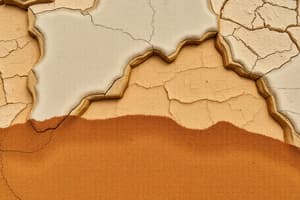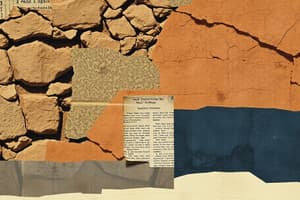Podcast
Questions and Answers
What are the primary processes through which sedimentary rocks form?
What are the primary processes through which sedimentary rocks form?
- Biological decay; radioactive decay; volcanic ash deposition
- Deposition of weathered material by water, wind, or ice; direct inorganic chemical precipitation from water; precipitation by organic processes (correct)
- Volcanic eruptions; tectonic plate movements; subduction
- Crystallization from molten magma; high pressure and temperature conditions; recrystallization
What is the main focus of Sedimentary Petrology?
What is the main focus of Sedimentary Petrology?
- Investigating the formation of igneous rocks
- Exploring the effects of metamorphism on rock formations
- Studying the composition, characteristics, and origins of sedimentary rock (correct)
- Analyzing the behavior of seismic waves in sedimentary layers
What are the main processes involved in the formation of sedimentary rocks?
What are the main processes involved in the formation of sedimentary rocks?
- Weathering, erosion, transport, deposition, diagenesis (correct)
- Biological decay, radioactive decay, volcanic ash deposition, crystallization
- Subduction, metamorphism, crystallization, recrystallization, deposition
- Volcanic eruptions, tectonic uplift, sublimation, sublimation, erosion
What are the outcomes of weathering on source rocks?
What are the outcomes of weathering on source rocks?
What are the major components of sandstone?
What are the major components of sandstone?
What is the most common mineral in sandstone, typically composing 65-100% of its composition?
What is the most common mineral in sandstone, typically composing 65-100% of its composition?
What is the size range of sand grains that define sandstone?
What is the size range of sand grains that define sandstone?
What type of matrix supports the clasts in paraconglomerate?
What type of matrix supports the clasts in paraconglomerate?
What are resistant lithologies less susceptible to?
What are resistant lithologies less susceptible to?
What affects mineral abundance in sandstone?
What affects mineral abundance in sandstone?
What is the texture of laminated pebbly mudrocks?
What is the texture of laminated pebbly mudrocks?
What does diamictite consist of?
What does diamictite consist of?
What further divides paraconglomerates?
What further divides paraconglomerates?
What are sand grains formed by?
What are sand grains formed by?
What are rock fragments useful in for sandstone studies?
What are rock fragments useful in for sandstone studies?
What can the disorganized matrix in paraconglomerates be?
What can the disorganized matrix in paraconglomerates be?
Which type of weathering involves changes to the minerals that make up a rock through processes such as dissolution, hydration, and oxidation?
Which type of weathering involves changes to the minerals that make up a rock through processes such as dissolution, hydration, and oxidation?
What are the agents of physical weathering that include freeze-thaw action, temperature change, salt dome intrusion, root wedging, wetting and drying, organic activity, and unloading?
What are the agents of physical weathering that include freeze-thaw action, temperature change, salt dome intrusion, root wedging, wetting and drying, organic activity, and unloading?
In which type of weathering does the physical breaking up of rock into smaller pieces occur in cold climates, high altitudes, and dry regions?
In which type of weathering does the physical breaking up of rock into smaller pieces occur in cold climates, high altitudes, and dry regions?
What involves the removal of material by mobile agents such as water, wind, ice, or man?
What involves the removal of material by mobile agents such as water, wind, ice, or man?
What is used to distinguish between laminar and turbulent motion in fluid flow?
What is used to distinguish between laminar and turbulent motion in fluid flow?
What are the different modes of transport for sediment, including rolling, saltation, and suspension?
What are the different modes of transport for sediment, including rolling, saltation, and suspension?
What flows have almost no mixing and thoroughly mix heterogeneous fluids?
What flows have almost no mixing and thoroughly mix heterogeneous fluids?
What includes volcaniclastic sediments, terrigenous clastic material, carbonates, evaporites, and other sediments and sedimentary rocks?
What includes volcaniclastic sediments, terrigenous clastic material, carbonates, evaporites, and other sediments and sedimentary rocks?
What makes up a significant portion of the sedimentary rocks in the stratigraphic record?
What makes up a significant portion of the sedimentary rocks in the stratigraphic record?
Which factor controls weathering and includes source composition, climate, and topographic relief?
Which factor controls weathering and includes source composition, climate, and topographic relief?
What involves the physical breaking up of rock into pieces without involving chemical reactions?
What involves the physical breaking up of rock into pieces without involving chemical reactions?
What involves changes to the minerals that make up a rock through processes such as dissolution, hydration, and oxidation?
What involves changes to the minerals that make up a rock through processes such as dissolution, hydration, and oxidation?
What is the equation for the Wentworth Scale to measure grain size?
What is the equation for the Wentworth Scale to measure grain size?
Which type of sedimentary rock is categorized based on grain size?
Which type of sedimentary rock is categorized based on grain size?
What distinguishes extraformational conglomerates from intraformational conglomerates?
What distinguishes extraformational conglomerates from intraformational conglomerates?
What characterizes petromict conglomerates?
What characterizes petromict conglomerates?
What makes up about 5% of the stratigraphic record?
What makes up about 5% of the stratigraphic record?
Which mineral is a major component of terrigenous clastic sediments and sandstone, averaging 10-15% and reaching 50% in arkoses?
Which mineral is a major component of terrigenous clastic sediments and sandstone, averaging 10-15% and reaching 50% in arkoses?
What method is used for sandstone classification by examining a thin section on a petrographic microscope to yield the proportion of each component?
What method is used for sandstone classification by examining a thin section on a petrographic microscope to yield the proportion of each component?
What type of sandstone has at least 95% quartz grains and is considered the most compositionally mature?
What type of sandstone has at least 95% quartz grains and is considered the most compositionally mature?
Which heavy mineral gives indications of provenance and source area events in terrigenous clastic sediments and sandstone?
Which heavy mineral gives indications of provenance and source area events in terrigenous clastic sediments and sandstone?
What type of climate favors the formation of arkoses, which are typically red or pink due to the presence of finely disseminated hematite?
What type of climate favors the formation of arkoses, which are typically red or pink due to the presence of finely disseminated hematite?
What do quartz arenite sandstones typically consist of?
What do quartz arenite sandstones typically consist of?
What do mica and clay minerals in sandstones and coarse clastics reflect?
What do mica and clay minerals in sandstones and coarse clastics reflect?
What can be used to identify petrographic provinces within a formation and reflect the effects of weathering and transport on their assemblage?
What can be used to identify petrographic provinces within a formation and reflect the effects of weathering and transport on their assemblage?
What are other components of terrigenous clastic sediments and sandstone, aside from heavy minerals?
What are other components of terrigenous clastic sediments and sandstone, aside from heavy minerals?
What influences the color of arkoses, making them typically red or pink?
What influences the color of arkoses, making them typically red or pink?
What is the study of heavy minerals used to identify within a formation?
What is the study of heavy minerals used to identify within a formation?
What type of sandstone can be formed in situ by extreme chemical weathering or persistent wave or current reworking on stable cratons and passive margins?
What type of sandstone can be formed in situ by extreme chemical weathering or persistent wave or current reworking on stable cratons and passive margins?
Flashcards are hidden until you start studying
Study Notes
Weathering, Erosion, and Sedimentation
- Physical weathering breaks solid rock into pieces without involving chemical reactions
- Agents of physical weathering include freeze-thaw action, temperature change, salt dome intrusion, root wedging, wetting and drying, organic activity, and unloading
- Mechanical weathering involves the physical breaking up of rock into smaller pieces, occurring in cold climates, high altitudes, and dry regions
- Examples of mechanical weathering include frost wedging, heating and cooling, wetting and drying, and the action of organisms
- Chemical weathering involves changes to the minerals that make up a rock through processes such as dissolution, hydration, and oxidation
- Factors controlling weathering include source composition, climate, and topographic relief
- Erosion involves the removal of material by mobile agents such as water, wind, ice, or man
- Transportation of sediment occurs through air, water, ice, and gravity, with different modes of transport such as rolling, saltation, and suspension
- Flows can be laminar or turbulent, with laminar flows having almost no mixing and turbulent flows thoroughly mixing heterogeneous fluids
- The Reynolds number is used to distinguish between laminar and turbulent motion in fluid flow
- Sediment origin and classification include volcaniclastic sediments, terrigenous clastic material, carbonates, evaporites, and other sediments and sedimentary rocks
- Limestones, sandstones, and conglomerates make up a significant portion of the sedimentary rocks in the stratigraphic record
Terrigenous Clastic Sediments and Sandstone: Key Components and Classification
- Feldspar is a major component of terrigenous clastic sediments and sandstone, averaging 10-15%, but reaching 50% in arkoses, and is less stable than quartz due to low chemical stability.
- Mica and clay minerals, including muscovite and biotite, are common in the matrix of sandstones and coarse clastics, reflecting source geology, climate, and weathering processes.
- Heavy minerals, such as apatite, epidote, garnet, rutile, staurolite, tourmaline, and zircon, give indications of provenance and source area events, with major changes in source-area geology being recorded in their assemblage.
- The study of heavy minerals can be used to identify petrographic provinces within a formation and reflect the effects of weathering and transport on their assemblage.
- Other components of terrigenous clastic sediments and sandstone include fossils, non-skeletal grains, skeletal phosphate, glauconite, chamosite, and organic matter.
- Dott’s scheme point counting is a method used for sandstone classification, involving the examination of a thin section on a petrographic microscope to yield the proportion of each component.
- Quartz arenite sandstones, with at least 95% quartz grains, are the most compositionally mature and are typically the products of extended periods of sediment reworking, influenced by climate and relief factors.
- Many quartz grains in quartz arenites are 2nd cycle and can be formed in situ by extreme chemical weathering or persistent wave or current reworking on stable cratons and passive margins.
- Arkoses, with over 25% feldspar, are typically red or pink due to the presence of finely disseminated hematite and are derived from granites and gneisses, influenced by climate, relief, and degree of transportation.
- Arkoses formation is favored by humid and glacial climates, where feldspars weather to clay, and rapid erosion in areas with high relief can also produce arkosic detritus.
Studying That Suits You
Use AI to generate personalized quizzes and flashcards to suit your learning preferences.




